Words have fallen short to describe the magnum opus of Indian cinema, the movie which has gone onto break all records and is now the first Rs 1000 crore earner at the box-office. Baahubali 2 has won hearts across the globe which isn’t an easy feat to achieve! The credit goes to the vision and the belief that director S S Rajamouli had in the project and in his team. A perfect example of how good content backed by a strong marketing and promotional campaign can create magic with audiences and at the box office.
Baahubali 2 (BB2) is like a ray of light for the Indian VFX industry, as it not only showcased what we can achieve with it but also made storytellers realise its true untapped potential. Billed as a visually extravagant movie, the credit goes to the creative and technical brains working round the clock to bring Rajamouli’s vision to life. Baahubali 2 comprises of 2,250 VFX shots – the labour of about 1,000 artists working on it over a span of 16 months.
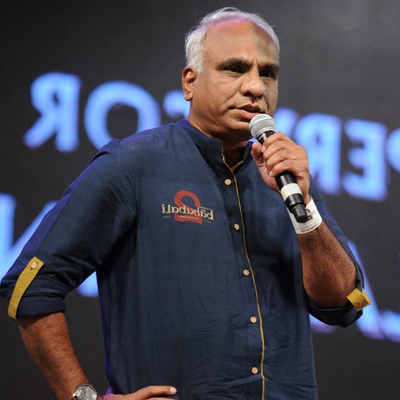
To supervise this project, National Film Awards winner, VFX supervisor RC Kamalakannan was roped in during BB2’s pre-production stage which was mid-October, 2015 and the shoot began by mid-December, 2015.
VFX supervisor, Srinivas Mohan had been signed on for the first instalment, however due to his previous commitments he couldn’t work on BB2. However, he did partly work on it during the first part schedule, mainly on the interior scenes of Mahishmathi Palace.
This isn’t the first time Kamalakannan was hired by Rajamouli for a film. Previously he has been associated with him for movies like Sye, Magadheera and Eega.
Kamalakannan opens up about how his latest stint with S S Rajamouli panned out, what went into the making of BB2, the various technical aspects and gives his views on the current situation of the Indian VFX industry.
Apologetically Kamalakannan says, “S S Rajamouli and I had a good rapport in previous projects, but when I quit Makuta VFX before the release of Eega, he didn’t take it lightly, which resulted in me not being hired for BB1. During our first meeting for BB2, SSR mentioned he was “cornered” into hiring me. I was sorry for what happened earlier and promised to stay till the end of this project, which I did. Hope he and the producers are happy now.”
Though one would have expected him to have been intimidated by people’s expectations from BB2, especially as it followed a super successful first edition, Kamalakannan claims it was not as challenging as some of his earlier projects.
The Beginning
When Kamalakannan was hired, he went about putting together his team. Knowing Rajamouli’s and Senthil Kumar’s (cinematographer) working style, he decided to use a “known” on-set supervisor and the professional he identified for it was Pete Draper (Makuta VFX, co-founder and chief technical director).
So, all shooting schedules were kept as planned. Assets creation was started early November, 2015 and pre-visualisation for the ‘Kunthala Rajya Invaders’ sequence and ‘Climax War’ was locked as early as February, 2016.
“VFX shot division was given to stunt choreographer, Lee Whitaker, as early as possible. On the post front, Cerebro, the project management software was decided upon the other ones. Since Germany has good security and fast response features, all post related data storage was decided to be over there. Pipeline was laid, work-flow was in place by the time we started the shoot.”
To work on a project of this magnitude, it is important for the VFX supervisor to have proper planning and co-ordination with everyone especially the director, producer and cinematographer. Since, the second part has many VFX based scenes, the production house and director considered a couple of VFX supervisors from abroad, before finalising on Kamalakannan.
Once he was brought on board, he was given a clear hand; his decision would be final. He explained this giving us an example of ‘The breakage of Dam in Kunthala War.’
“I decided to use Miniature Practical FX, and that too with a previously unknown studio in Denmark. I had the whole team’s co-operation. Prior to filming major sequence, there used to be a full team meeting which had to be attended by all the ADs, ACs, art, stunt and VFX team. In certain shots, if I felt it required sharper images, I used to ask the DoP to change the shutter-angle without any hesitation. In many cases, the director himself used to decide on the VFX prop, with Sabu Cyril sir. Overall it was a systematic work environment, totally in the line producer’s control.”
His core team included VFX producer, Avinash Kamalakannan; pipeline technical director who also functioned as his 3D quality controller, Alexander Oplanchuk; compositing supervisors, Mohinder and Thejodaran; senior line producers, Chandramohan and Sanjith; DI co-ordinator, Raghav; project manager who controlled Cerebro, Ramakrishna Arvind; and two young assistants, Mayur and Surya.
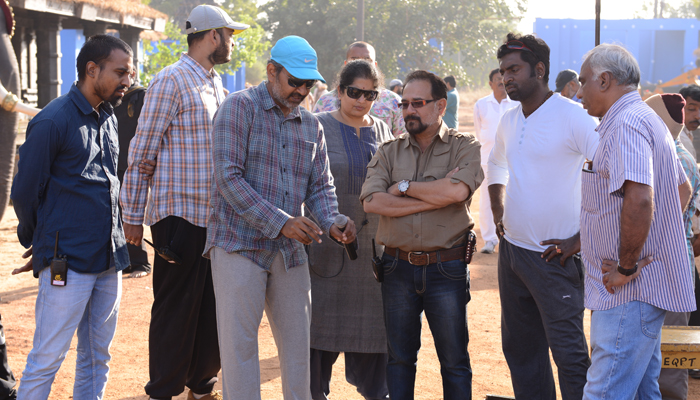
The Preparation
Various assets were required to showcase the larger than life palaces, cities, wars and many other things. In BB1, Makuta had done a 3D architectural model of Mahishmathi Palace in 3ds Max. Kamalakannan managed to convert it to BB2’s common Maya / Arnold pipeline as it had to be distributed for the coronation and climax sequences. For the coronation, the director wanted more areas of the Mahishmathi City center which helped him in making the changes quickly. Apart from that, the rest of the assets were made for BB2.
As a lot of studios were required in the making of the movie, with the help of his VFX producer, Kamalakannan took the call on who will be working on this movie and what work will be assigned to whom. “Producer Shobu Yarlagadda visited Ukraine studios but those studios were too busy to fit in our timeline. For the climax, we looked at Mumbai-based studios. The studios were selected on the basis of the tasks and not scene / shot based which proved to be a good move.”
Normally, the budget plays a crucial role for features of this scale. However, since the budget for Makuta VFX work was off-limits to Kamalakannan, he couldn’t tell much about it.
Since the beginning of BB2, more than 35 studios were involved. Earlier they used several of them for asset generation, and later, in the last two months a few more were added to split the work. A precise number couldn’t be pointed out as few of them weren’t in Cerebro.
So how did he go about locking down these studios and who was the decision maker: Rajamouli or him?
“Since I had previously worked with seven to eight studios, I was well aware of their strengths. For the rest of the studios, I travelled with ‘concepts, mood-boards, pre-visualisation’ package for a week / 10 days, discussing with at-least two new studios simultaneously after an NDA was signed. I used to scrutinise their reels, enquire about them discreetly to know if the skills showcased in the reels were still present in the company,” says Kamalakannan.
“In certain scenes, ONE shot had gone through six or seven studios. This way studios could work in what they are good at and didn’t spend time on peripheral R&D. This coupled with a gut instinct, the studios were locked down at the LAST possible moment. Once I locked it, we used to discuss the cost, get the producer’s go-ahead and then send the details to the director. He would ask a couple of questions, and that’s all. As far as correct decisions are concerned, apart from one case, rest of my decisions were proven right.”
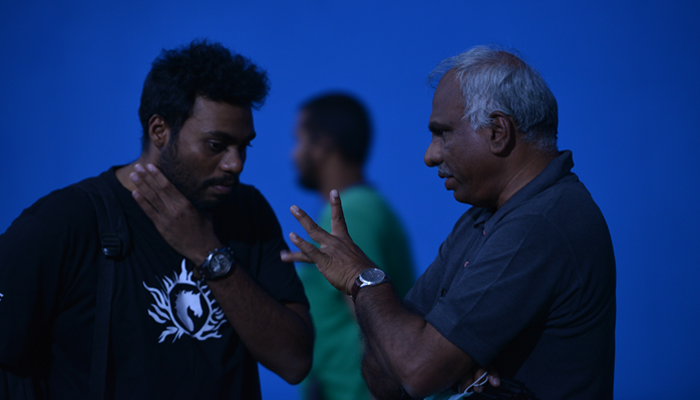
The Technical Nitty-Gritties
With the association of these many studios, each studio might be working on different software. However, that wasn’t an issue as the pipeline was laid much earlier. The workflow was discussed and locked based on the scene / shot complicity and a NDA was common for all. Except the last two scenes in the first half — the coronation (Exterior) and swan-ship song — rest of the studios were following the same pipeline. Since the post-production deadlines for these two scenes were tight, he forego those conditions.
Once the edit was locked, the director used to give his description (on what is needed shot wise) in a video clip. This was uploaded in Cerebro which the studios / freelancers had to follow. For all the scenes, post-visualisation had to be submitted to Avid and then approved. Later, when rough compositing was submitted, the director gave a video review for all the shots (mostly creative corrections), till he was satisfied.
Then final compositing QTs, with few EXR frames submissions to the comp supervisors were done again through Cerebro. The latter used to do the technical corrections. At any point the director could veto their output. Then in the digital intermediate (DI), the director of photography (DoP) had to approve the look of all the shots and sometimes, he used to send couple of them back to basics, even all the way to match-move, again!
With such a lengthy procedure and number of studios working, co-ordinating with all could have been a daunting task. How did they manage to pull it off?
“It is teamwork. My VFX producer, comp supervisors, line producers and I were constantly travelling to meet all those working directly on the shots. The pivotal artist had the data needed for all 2000 odd shots in Cerebro. The ‘inputs’ were majorly Arri files, with CC files from DI shared via Cerebro. The match-move for ALL shots were out-sourced to two studios, with one of them handling 70 to 80 per cent of the work. Lidar data was provided to make match moves seamless,” says Kamalakannan.
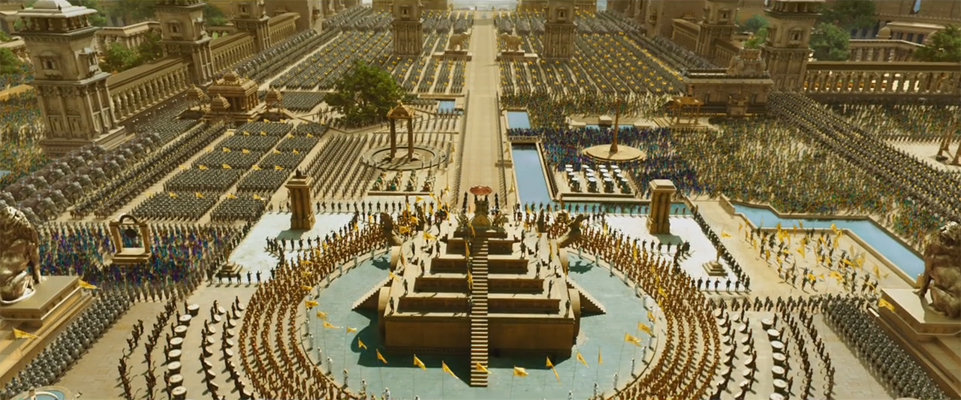
“Roto and prep work were handled by separate contractors, and the assets, textured and rigged from other studios, were also in Cerebro. The production had a 10 system render-farm installed, so, initial render tests could be submitted by ANY studio via virtual private networks (VPN). We-render, from Pune, was roped in to offer render farm services. All the studios could use We-render, free of their contract-cost. These liberal decisions from producers facilitated timely delivery.”
The pipeline used was clear – Maya, Arnold, Yeti, Nuke / Fusion. For FX, most studios used Houdini / Alembic route. The Elephant sequence (and opening credits) was rendered and composited in Deep EXR, since the scene needed it. For Crowd FX, Massive for War, Golaem and Miarmy for Kunthala scene.
As for the burning oxen shot, we did see the same type of scene in the 2015 release film, Bajirao Mastani. So one may wonder if there were any assets shared by NY VFXWAALA. Kamalakannan clarifies, “Frankly, the burning oxen idea was conceived before Bajirao Mastani was released. No, NY VFXWAALA was involved in climax war. They did a tremendous job along with other principal studios like After, Futureworks and Tata Elxsi.”
For the swan-ship and coronation sequences, the studios used different render engines. No restrictions were put on the hardware or OS. Any studio could use the official render-farm partner, We-render.
The final editing and collating of all the shots were done by the director and editor.
Since the movie had to be delivered in 4K, the inputs were in 2880×2160 whereas the outputs were 2880×1620. As for IMAX, it was digitally enhanced.
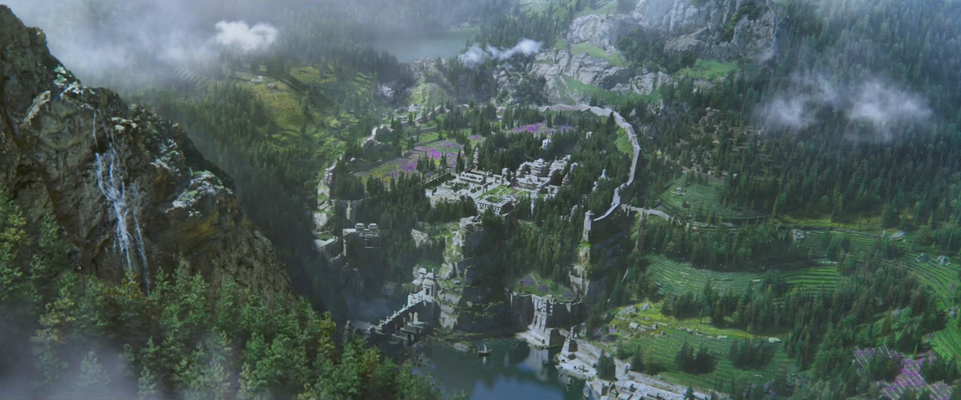
The End result
Having waited for almost two years, we expected the movie to have flawless VFX. However, there were certain shots where it was evident that they were created and simulated.
So what stopped the team from achieving that?
“Since the shoot started in mid-December 2015 and the release was on 28 April, we had 16 months with us. Not two years,” comments Kamalakannan. “True, another three more months would have helped me a lot. (Producer might ask this: The production did postpone the Part 1 release a few times, is it flawless?)”
He feels that the VFX could have been improved if the studios had more lead time. “I am not entirely happy as there was certainly room for improvements, from some principal studios, who were given more-than-enough time. I think they expected the release to be a bit later and not so soon which was their mistake.”
Having worked on a movie which is regarded as one of the best works of Indian cinema, he states, “Of-course I feel very happy as we not only managed to finish it on dead-line, but in best possible quality. Personally, when Mrs. Rama Rajamouli said, I’m the best (they both used to say it before), it made my day.”
This project helped Kamalakannan to learn a lot about skills and attitudes. He believes that on a personal front, he has also changed and is now more positive. Earlier he used to believe that he had seen his best, but now he says, “My best is yet to come.”
Kamalakannan further mentions that Rajamouli was the pivot and all were moving around him. He has enough knowledge to handle overall supervision himself. He goes on to request him “to release a video for the young upcoming directors talking about how to handle VFX based projects. It will help supervisors like us immensely.”
Kamalakannan has high regards for the entire cast and crew. He says, “Prabhas, a non-egoistic hero, gave immense respect to me on set. Earlier, Rana was a VFX guy himself and so has immense knowledge about it. Anushka, served some great dishes made from home. Satyaraj sir a thorough pro, who laughed around, when he was on-set. Senthil is a made for VFX DoP. As for Shobu and Prasad garu, I would like to work in more projects they are producing. Finally comes SS Rajamouli. I am waiting for him to call me again, to confirm I’m the best.”
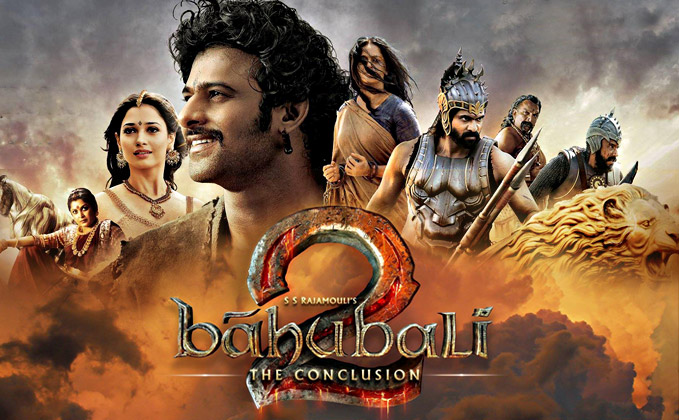
The Conclusion
Though the costs, budgets and wages of VFX have gone up, when it comes to rating the work of the Indian studios in comparison to our Hollywood counterparts, he comments, “As long as Hollywood studios have the ability, to write their own applications, tailor made for their projects need, we can’t catch up.”
Kamalakannan feels that Mumbai studios have really picked-up pace and Bengaluru is getting better. However, Hyderabad and Chennai are lagging behind on the quality front.
“People say, the best skills from these two regions have gone to Mumbai now. Maybe true, but I request Hyderabad and Chennai to prepare the next-gen and bring the lost glory again. Pan India, yes, I am satisfied with the work.”
Kamalakannan points out a few changes in film production timelines and schedules will help a great deal in integrating and scaling up the quality of VFX. Says he: “These days, production plans are open secret. Till the time audio release date isn’t fixed, studios will not be serious on delivery. And once deadline is fixed, studios call the shots on quality. This has to be changed.”
He is currently busy with two projects with Sabu Cyril: Sangamithra (Tamil) and Saaho (Telugu).